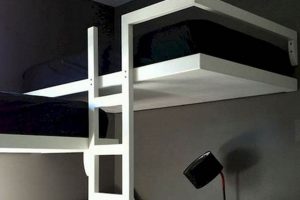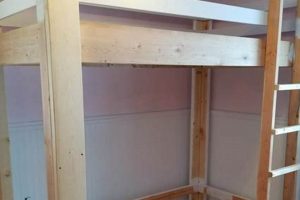A sliding platform designed for truck beds allows for easier access to items stored within the cargo area. This facilitates loading and unloading materials by bringing them closer to the tailgate, reducing the need to climb into the bed. Construction typically involves using materials like wood, metal, or durable plastics, configured to slide along rails or runners. An example would be a homeowner building a custom platform to simplify hauling groceries, tools, or recreational equipment in their pickup truck.
The value of such a platform lies in increased convenience and reduced physical strain. It minimizes reaching and lifting, potentially preventing back injuries. Historically, simpler solutions like tarps and ropes were employed to manage cargo, but the advent of engineered sliding systems represents a significant advancement in cargo management technology. The benefits extend to various applications, from construction workers accessing tools to outdoor enthusiasts managing camping gear.
The following sections detail the considerations involved in designing and building these platforms, encompassing material selection, construction techniques, and safety precautions. This provides a thorough guide for those seeking to create a customized cargo management solution. Factors influencing the design, such as load capacity and the type of truck bed, will also be examined.
Essential Considerations for Truck Bed Sliding Platforms
The construction of a truck bed sliding platform demands careful planning and execution to ensure both functionality and safety. The following tips offer guidance on critical aspects of the build process.
Tip 1: Precise Measurement is Paramount. Accurate measurements of the truck beds interior dimensions are essential. Account for wheel well protrusions and any bed liners that may affect available space. Inaccurate measurements can lead to a poorly fitting platform that is difficult to operate.
Tip 2: Material Selection Dictates Durability. Choose materials based on anticipated load and environmental conditions. Pressure-treated lumber or steel are suitable for heavy-duty applications, while lighter materials like plywood may suffice for lighter loads. Weather-resistant coatings are crucial in all cases to prevent degradation.
Tip 3: Secure Fastening is Non-Negotiable. The platform must be securely fastened to the truck bed to prevent shifting during transit. Utilize heavy-duty bolts and appropriate anchoring methods to ensure stability, particularly under heavy loads and during abrupt stops.
Tip 4: Implement a Robust Sliding Mechanism. The sliding mechanism should be durable and capable of handling the intended weight. Consider using heavy-duty drawer slides or rollers with a high load rating. Regular lubrication of the sliding components is vital for smooth operation.
Tip 5: Incorporate Safety Latches. A locking mechanism is essential to prevent the platform from sliding unintentionally, particularly on inclines. Implement a reliable latching system that secures the platform in both the extended and retracted positions.
Tip 6: Prioritize Weight Distribution. When loading the platform, distribute weight evenly to prevent excessive stress on any single point. Uneven loading can lead to structural failure and compromise the sliding mechanism.
Tip 7: Regular Inspection and Maintenance are Necessary. Regularly inspect all components, including fasteners, sliding mechanisms, and structural members, for wear and tear. Address any issues promptly to prevent further damage or potential safety hazards.
Adhering to these tips ensures a safer, more functional, and longer-lasting truck bed sliding platform. Attention to detail during the construction process translates directly into improved utility and peace of mind.
The concluding section will delve into advanced design considerations and potential enhancements for enhanced performance and customization.
1. Dimensions (accurate)
The accurate determination of dimensions serves as the foundational element in the successful construction of a DIY truck bed slider. Incorrect measurements directly compromise the sliders functionality and may render the entire project unusable. A slider designed with inaccurate dimensions fails to operate smoothly, potentially binding or becoming completely immobile. This stems from interference with the truck beds internal contours, such as wheel wells or pre-existing mounting points. As a direct consequence, the intended utility of easier cargo access is nullified.
For example, a DIY slider built with dimensions exceeding the available space cannot be fully retracted, obstructing the truck bed and preventing the tailgate from closing properly. Conversely, a slider built with dimensions smaller than required results in excessive play and instability, increasing the risk of cargo shifting during transit. The structural integrity of the slider is also jeopardized by dimensional inaccuracies. Misaligned support structures introduce stress points, potentially leading to premature failure under load. In practical terms, accurate dimensions represent a preventative measure against wasted materials, time, and effort.
In summary, the relationship between accurate dimensions and a functioning DIY truck bed slider is causal and indispensable. Accurate measurements are not merely a suggestion; they are a prerequisite for a successful and safe implementation. The challenges stemming from dimensional inaccuracies are significant and directly impact the sliders performance and lifespan, underlining the critical importance of precise measurement in the DIY construction process.
2. Material Selection
Material selection significantly influences the performance and longevity of a DIY truck bed slider. The chosen materials dictate the slider’s load capacity, resistance to environmental factors, and overall durability. Selecting inappropriate materials compromises the slider’s intended functionality and poses potential safety risks.
- Wood Composites: Plywood and Oriented Strand Board (OSB)
Plywood offers a balance of strength and affordability for slider decks. Its layered construction resists warping and provides a stable surface for cargo. OSB, a cheaper alternative, is suitable for lighter loads but is more susceptible to moisture damage. A homeowner constructing a light-duty slider for occasional use might opt for plywood, while a contractor hauling heavier equipment would require a more robust material. Untreated wood composites will quickly degrade in exposed environments.
- Metals: Steel and Aluminum
Steel provides exceptional strength and durability, ideal for heavy-duty sliders designed to withstand significant weight and abrasion. However, steel is prone to rust and requires protective coatings or finishes. Aluminum offers a lighter-weight alternative with good corrosion resistance but generally carries a higher price tag. A fabrication shop building sliders for industrial use often chooses steel, while an individual seeking a lightweight solution may prefer aluminum.
- Plastics: High-Density Polyethylene (HDPE) and Polypropylene (PP)
HDPE and PP offer excellent resistance to moisture, chemicals, and impact, making them suitable for sliders exposed to harsh conditions. These materials are also lightweight and relatively easy to fabricate. However, plastics generally have lower load-bearing capacities compared to wood composites or metals. A landscaper using a slider to transport fertilizers and other chemicals might find these materials advantageous. Their reduced weight also contributes to fuel efficiency.
- Sliding Components: Rollers and Bearings
The choice of rollers or bearings directly impacts the sliders ease of operation and load-bearing capacity. Steel rollers offer high load capacity and durability but can be noisy. Polyurethane rollers provide quieter operation and good abrasion resistance. Bearings reduce friction and allow for smoother, more controlled sliding action. A slider intended for frequent use with heavy loads should incorporate robust rollers or bearings to ensure reliable performance and prevent premature wear. The long-term functionality of the entire system depends on these seemingly small parts.
In conclusion, the selection of materials for a DIY truck bed slider is a critical decision with far-reaching implications. Consideration must be given to the intended use, environmental conditions, load requirements, and budget constraints. A well-informed material selection process ensures a slider that is both functional and durable, providing years of reliable service. Ignoring these factors results in a compromised system susceptible to premature failure.
3. Fastener Strength
Fastener strength represents a critical element in the construction of any DIY truck bed slider. The integrity of the entire structure rests upon the ability of these components to withstand the forces generated during use. Inadequate fastener strength directly correlates with potential structural failure, leading to cargo damage, personal injury, and operational inefficiencies. The choice of fasteners is not merely a matter of convenience; it is a fundamental safety and performance consideration. The shear, tensile, and yield strengths of the selected fasteners must exceed the anticipated stresses imposed by the weight of the cargo and the dynamic forces of movement during vehicle operation.
Consider the scenario of a contractor transporting heavy equipment on a DIY slider. If the fasteners connecting the slider deck to its frame fail due to insufficient strength, the entire load can shift unexpectedly. This shift presents an immediate safety hazard, particularly during braking or turning maneuvers. Furthermore, the resulting damage to equipment and the truck bed represents a significant financial setback. In another example, a DIY slider constructed using undersized or low-grade fasteners may experience premature wear and tear, requiring frequent repairs and increasing the risk of catastrophic failure over time. This underlines the importance of selecting fasteners with appropriate specifications for the intended load and usage conditions. Using the right grade of bolts, screws, or rivets, along with proper installation techniques, is crucial for ensuring the long-term reliability and safety of the slider.
In summary, fastener strength is not a secondary concern but a primary design consideration for DIY truck bed sliders. Understanding the mechanical properties of different fastener types and their suitability for specific applications is essential for a successful and safe build. Challenges in this area include accurately estimating the loads and forces that the slider will experience and selecting the appropriate fasteners based on these estimates. Ignoring this aspect of the project compromises the entire structure, negating the benefits of easier cargo management and potentially leading to costly and dangerous consequences.
4. Sliding Mechanism
The sliding mechanism represents the core functionality of any DIY truck bed slider. This component enables the controlled linear movement of the platform, allowing users to extend cargo from the truck bed for easier access. Without a properly functioning sliding mechanism, the entire purpose of the slider is defeated. The selection and implementation of this component directly dictate the load capacity, smoothness of operation, and overall durability of the slider. A poorly chosen or improperly installed mechanism may bind, require excessive force to operate, or fail completely under load. The cause-and-effect relationship is straightforward: a robust and well-engineered mechanism results in a reliable and user-friendly slider; conversely, a weak or flawed mechanism leads to a frustrating and potentially hazardous experience. Consider a scenario where a landscape contractor is unloading heavy bags of mulch from a DIY slider equipped with inadequate sliding components. If the rollers or bearings are unable to support the weight, the platform may become stuck mid-extension, requiring significant physical effort to move or even posing a risk of tipping. This example highlights the practical significance of selecting a sliding mechanism that is appropriately rated for the intended load and operating conditions.
Various options exist for implementing a sliding mechanism in a DIY truck bed slider, each with its own advantages and disadvantages. Heavy-duty drawer slides, commonly used in industrial applications, offer excellent load capacity and smooth operation but can be relatively expensive. Alternatively, simpler systems based on rollers and tracks can be fabricated using readily available materials, providing a more cost-effective solution for lighter-duty applications. The choice depends on the specific requirements of the project and the skill level of the builder. Regardless of the chosen approach, precise alignment and secure mounting of the sliding components are essential for optimal performance. Misalignment can cause binding and uneven wear, while loose mounting can lead to instability and premature failure. The practical application of a well-designed sliding mechanism extends beyond mere convenience. It also improves safety by reducing the need to climb into the truck bed, minimizing the risk of falls and injuries. For users with limited mobility, a smoothly operating slider can significantly enhance their ability to manage cargo independently.
In summary, the sliding mechanism is an indispensable component of any DIY truck bed slider, directly impacting its functionality, durability, and safety. Proper selection, installation, and maintenance of this component are critical for achieving the desired benefits of easier cargo access and reduced physical strain. Challenges associated with this aspect of the project include selecting the appropriate type and rating of sliding components, ensuring precise alignment and secure mounting, and mitigating the effects of friction and wear. Overcoming these challenges through careful planning and execution results in a truck bed slider that provides years of reliable service.
5. Safety Latches
Safety latches are critical components of any DIY truck bed slider, ensuring the platform remains securely in a designated position during transit and loading/unloading activities. Their inclusion directly mitigates risks associated with unintended platform movement, such as cargo shifting, equipment damage, or potential personal injury. The absence of reliable safety latches renders the slider inherently unsafe and undermines its intended utility.
- Prevention of Unintended Extension
Safety latches prevent the slider from extending unexpectedly while the vehicle is in motion or parked on an incline. Unintended extension introduces a safety hazard, potentially obstructing traffic lanes or causing cargo to spill onto the roadway. An example is a contractor transporting tools on a job site; a properly engaged safety latch prevents the slider from rolling out during transit, maintaining a secure load. Failure to incorporate this feature can result in equipment loss or damage and poses a significant liability risk.
- Securement During Loading and Unloading
During loading and unloading operations, safety latches maintain the slider’s position, preventing it from rolling back into the truck bed or extending further than intended. This stability is particularly important when handling heavy or unwieldy items. A homeowner loading furniture onto the slider benefits from a secure latching mechanism, which prevents the platform from shifting under load and potentially causing injury or damage. The absence of this feature necessitates greater physical exertion and increases the risk of accidents.
- Types of Latching Mechanisms
Various latching mechanisms can be employed, each with its own advantages and disadvantages. Pin-and-hole systems offer simplicity and reliability, while spring-loaded latches provide automatic engagement. Over-center latches offer high holding force and resistance to vibration. The choice of latching mechanism depends on the slider’s load capacity, intended use, and desired level of security. A heavy-duty slider used for industrial applications typically requires a more robust latching mechanism than a lightweight slider designed for recreational use. Properly installed, they serve as a great tool to prevent slider movement
- Integration with Slider Design
Safety latches should be seamlessly integrated into the overall slider design to ensure ease of use and reliable performance. The latching mechanism should be readily accessible and easy to operate, even when wearing gloves. The design should also prevent accidental disengagement of the latch. An ergonomically designed latching system enhances the user experience and promotes consistent use, further minimizing the risk of accidents. It contributes to both a user friendly and very safe diy truck bed slider.
In summary, safety latches are indispensable for any DIY truck bed slider, directly contributing to the safety and practicality of the device. These components are not optional add-ons, but rather essential elements that prevent unintended movement, secure the platform during loading and unloading, and mitigate potential risks. The proper selection, installation, and integration of safety latches are crucial for a functional and secure DIY truck bed slider.
6. Weight Distribution
In the context of a DIY truck bed slider, weight distribution is a foundational principle that directly affects the slider’s structural integrity, operational efficiency, and overall safety. Unevenly distributed weight creates concentrated stress points, potentially exceeding the load-bearing capacity of individual components. This, in turn, leads to premature wear, deformation, or even catastrophic failure. The cause-and-effect relationship is linear: improper weight distribution leads directly to reduced slider performance and increased risk of accidents. This critical aspect of slider design and usage cannot be overlooked.
The importance of uniform weight distribution becomes particularly apparent when considering real-world applications. Imagine a contractor loading heavy construction materials onto a DIY slider. If the majority of the weight is concentrated on one side of the platform, the corresponding bearings or rollers experience disproportionate stress. This stress leads to increased friction, making the slider difficult to operate, and can eventually cause the overloaded components to fail. Another example arises when transporting recreational equipment. Concentrating heavy items towards the front of the slider, closest to the truck cab, places undue strain on the forward support structure, potentially causing it to bend or buckle under repeated stress. Therefore, loading practices must account for the slider’s design limitations and the properties of the carried cargo.
Addressing weight distribution challenges involves several practical measures. First, the slider’s structural design should incorporate evenly spaced support members capable of withstanding the maximum anticipated load across the entire platform. Second, users must be educated on proper loading techniques, emphasizing the importance of distributing weight uniformly across the slider’s surface. Third, regular inspections should be conducted to identify any signs of stress or deformation, such as bent support beams or uneven roller wear. Implementing these practices ensures the long-term reliability and safety of the DIY truck bed slider, optimizing its performance and minimizing the risk of structural failure due to improper weight distribution.
Frequently Asked Questions
The following section addresses common inquiries regarding the design, construction, and implementation of a DIY truck bed slider. The aim is to provide clear and concise answers to promote safe and effective construction practices.
Question 1: Is specialized expertise required to construct a functional truck bed slider?
While advanced fabrication skills are not strictly necessary, a foundational understanding of woodworking or metalworking principles is beneficial. Familiarity with basic tools, measurement techniques, and structural concepts contributes significantly to a successful build.
Question 2: What is the typical cost associated with building a truck bed slider?
The cost varies considerably based on material selection, slider dimensions, and complexity of the design. A basic slider constructed from plywood and commercially available drawer slides may range from $100 to $300. More elaborate designs utilizing steel framing and heavy-duty components can exceed $500.
Question 3: How does the choice of materials impact the slider’s load capacity?
Material selection directly dictates the slider’s ability to withstand weight. Steel offers the highest load-bearing capacity, followed by hardwoods, and then plywood. Plastics are generally suitable for lighter loads. Consult material specifications to determine appropriate weight limits.
Question 4: What safety considerations are paramount during construction?
Safety should be prioritized throughout the entire process. Wear appropriate personal protective equipment, including eye protection, gloves, and hearing protection. Ensure a well-ventilated workspace and adhere to safe operating procedures for all power tools.
Question 5: How is the slider secured within the truck bed to prevent movement during transit?
Securement methods vary based on the slider’s design and the truck bed configuration. Common techniques include bolting the slider frame directly to existing mounting points in the bed, utilizing tie-down straps, or employing a combination of both.
Question 6: What maintenance is required to ensure the slider’s longevity?
Regular inspection and lubrication of moving parts are essential. Periodically check fasteners for tightness and address any signs of corrosion promptly. Protecting the slider from prolonged exposure to the elements extends its lifespan.
These FAQs provide a foundation for understanding the core aspects of building a DIY truck bed slider. Thoughtful planning and execution are crucial for achieving a safe and effective result.
The subsequent section will explore potential modifications and customization options to tailor the slider to specific needs.
DIY Truck Bed Slider
This exploration has outlined the multifaceted aspects of a DIY truck bed slider, from foundational design principles to critical safety considerations. The presented information emphasizes the importance of precise measurements, appropriate material selection, robust construction techniques, and the implementation of essential safety features. A well-executed platform of this type requires a comprehensive understanding of the involved engineering principles and meticulous attention to detail. These elements ensure a finished product that is both functional and reliable.
The construction of a DIY truck bed slider represents a significant undertaking, demanding both practical skills and a commitment to safety. Individuals considering such a project are strongly encouraged to thoroughly review the presented information, prioritize safety measures, and consult with experienced professionals when necessary. A successful build not only enhances the utility of the truck but also fosters a sense of accomplishment. The potential benefits warrant a measured and thoughtful approach to design and construction.



![DIY Truck Bed Rack: Build Your Own Bed Rack [Plans] The DIY Hub: Creative Crafts, Repairs & Life Hacks DIY Truck Bed Rack: Build Your Own Bed Rack [Plans] | The DIY Hub: Creative Crafts, Repairs & Life Hacks](https://craftingdiycenter.com/wp-content/uploads/2025/07/th-2452-300x200.jpg)



